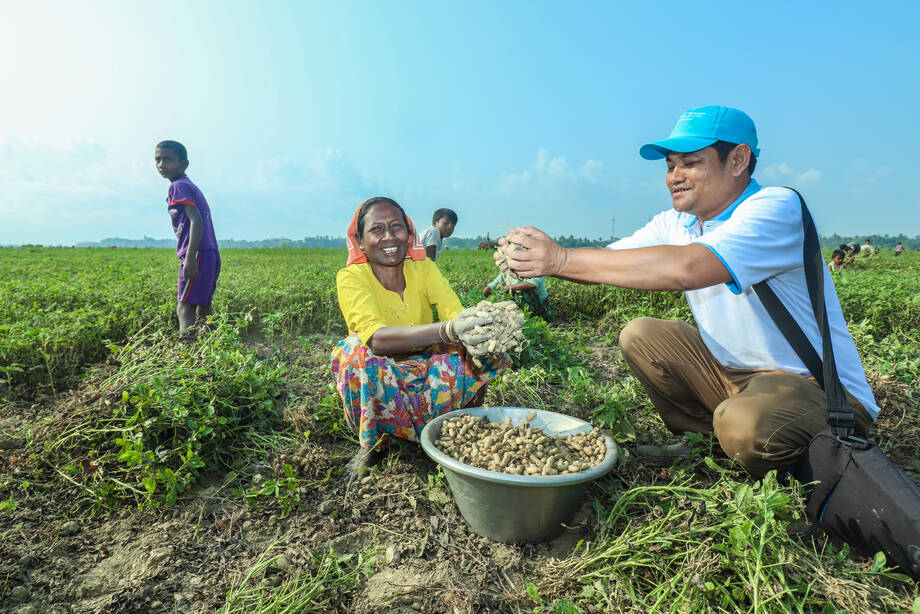FAO in Myanmar

The Food and Agriculture Organization (FAO) is a specialized agency of the United Nations that leads international efforts to defeat hunger. Our goal is to achieve food security for all and make sure that people have regular access to enough high-quality food to lead active, healthy lives. With over 194 member states, FAO works in over 130 countries worldwide.
FAO, a technical agency under the United Nations system has a long history of cooperation in the country since Myanmar became a FAO Member State in 1947. The FAO Representation was established in 1978 and has been present in Myanmar for 74 years. Dr. Yuka Makino, a national of Japan, was appointed as the FAO Representative in Myanmar in July 2021.
FAO supports rural livelihoods, farmers and vulnerable groups in Myanmar in collaboration with various stakeholders, development partners and public and private institutions.
FAO Operations in Myanmar
Since the very beginning, FAO has committed to support the country in defeating hunger and achieving sustainable food and nutrition security. With its technical expertise and comparative advantage, FAO has been delivering a wide range of projects and programmes in Myanmar. Over the past decades, FAO’s projects and programme continuously supported the country in strengthening policy planning and implementation across the country’s agriculture sector, and field-level interventions providing immediate and long-term support to farmers and rural livelihoods. During its seventh decade journey of working in Myanmar, FAO has implemented over 270 projects through national, regional, and global initiatives. These activities have contributed to the country’s hunger reduction and improvement of food security through supporting the process of evolution of the agriculture sector, while providing emergency assistance.
Under the context of Country Programming Framework (CPF) for Myanmar (2017-2022), FAO’s field programme in Myanmar consists of technical cooperation as well as emergency assistance, including direct support to agriculture-dependent communities. Recent interventions in the country have focused on enhancing and diversifying agricultural production, promotion of nutrition sensitive and climate smart agriculture, sustainable land management, integrated pest management, improvement of livestock production, and reduction of post-harvest losses. In addition, enhance sustainable forestry and natural resource management, improve the sustainability of small-scale fisheries and aquaculture in inland and coastal ecosystem, transboundary animal disease, mitigate and adapt to climate change, disaster risk reduction, and strengthen the adaptive capacity and resilience of crops, livestock, fisheries and aquaculture-dependent livelihoods.
Since the spread of the COVID-19 pandemic in 2020, FAO’s projects and programme have been reoriented and focused on delivering its assistance to rural livelihoods and communities.
Resilience building and emergency assistance to meet unexpected and immediate needs
The Global Climate Risk Index 2017 ranked Myanmar among the three countries most affected by weather related events, which are leading regularly to displacement of people, destruction of livelihoods, crops and other food sources. Impact data show that the agriculture sectors alone are absorbing up to 30% of the total loss and damage caused by natural hazard induced disasters on the country. In the future, as the Myanmar Climate Change Strategy 2018-2030 highlights - natural disasters and extreme events will even further increase in frequency and intensity as consequence of climate change; and also risks of transboundary animal disease (TAD) emergencies, zoonotic emerging infectious diseases (EID) and antimicrobial resistance (AMR).
With the Vision of ‘Protected lives, economy, heritage and environment, through inclusive approach, towards sustainable development in Myanmar’, FAO provided technical assistance to develop the Agriculture Action Plan for Disaster Risk Reduction (APPDRR) (2019) in line with the Myanmar Action Plan on Disaster Risk Reduction (MAPDRR).
Food insecurity in Myanmar continues to be driven by the impacts of the protracted armed conflict, inter-communal tensions, displacement and recurrent climate-related shocks. The impacts of the coronavirus disease 2019 (COVID-19) and the socio political unrest and economic instability have worsened the situation, further limiting access to and availability of food.
FAO Emergency program in Myanmar is working on: i) Rebuilding agriculture-based livelihoods through supply of agricultural, livestock and aquaculture inputs and cash transfer, training on good agriculture practices, climate smart agriculture, nutrition, hygiene and COVID-19 risk mitigation, provision land preparation harvesting equipment, improving animal health services; ii) Rehabilitating productive infrastructure and contribute to conservation through fishpond renovation and construction through cash-for-work and agricultural land rehabilitation; and iii) Improving disaster Risk Reduction, early warning and anticipatory action systems as well as community based disaster risk management.
In order to support for strengthening the adaptive capacity and resilience of fisheries and aquaculture-dependent livelihoods in Myanmar, FAO has been implementing FishAdapt project since 2017 in Yangon, Rakhine and Ayeyarwady. As Covid-19 pandemic disrupted field implementation at community level, FAO considered to cope these issues with innovative way. This brought the idea to develop Peer – to – Peer Platform (android mobile application-beta version) that designed to facilitate E-Learning opportunities, sharing Early Warning Early Actions (EWEAs) notifications for disaster risk and market information for fisheries communities. The P2P platform was launched in 26 August 2021 available here.
Furthermore, FAO provides continuous technical support to prevent and control transboundary animal diseases. The animal health programme, linked to regional disease control strategies, builds national capacity to reduce the risks and impact of emerging infectious diseases, antimicrobial resistance, and bio-threats through an inclusive One Health approach.
